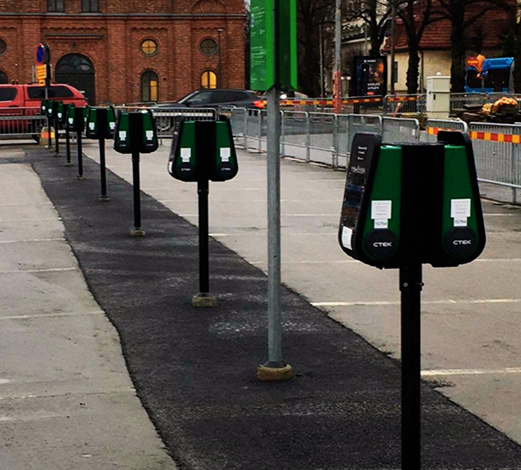YouGov Survey reveals shift in driver demand towards public EV charging

With ownership of electric vehicles (EVs) continuing to grow, a YouGov survey conducted on behalf of vehicle charging specialists CTEK has revealed that more drivers are now looking to charge their EVs in public, rather than at home.1
The survey reveals that, while 68% of EV drivers still prefer to charge their vehicles at home, more than a third (37%) of EV drivers are now using public chargers, 12% are charging at work and 9% at petrol stations.
Cecilia Routledge, CTEK’s Global Head of E-Mobility, said: “With previous estimates of up to 90% of EV charging taking place at home, this is a fairly significant shift, and we can expect the need for public charging to intensify as coronavirus restrictions in the UK continue to be lifted. Not only that, permanent changes to working patterns and more home working are likely to result in people visiting their workplace less often, so EV owners with nowhere to install a home charger will increasingly need to rely on public chargers and those at destinations like shopping centres and supermarkets.”
The low use of petrol station charging also indicates that drivers prefer to combine charging with a longer stop, perhaps to do a bit of shopping, have a coffee or a bite to eat. But the survey reveals that availability and reliability of chargers, or not knowing the location of them, remains a concern for existing EV drivers (30%) and those considering an EV (39%). Charger reliability was also one of the two main concerns raised by local authority representatives attending the Everything EV Summit in April, with the other key concern raised by local authorities being the availability of power from the grid.
CTEK has the following advice and guidance for local authorities looking to install or expand public EV charging networks.
- AC/DC. CTEK’s research reveals that the typical charge at a public chargepoint is around 10 kWh, and that vehicles are plugged in for approximately 3 hours, with drivers generally topping up their battery rather than charging from empty. CTEK therefore recommends that, in public parking spots where drivers are likely to stop for longer and are in less of a rush, expensive rapid charge DC (direct current) chargers are rarely needed, and AC (alternating current) chargers that deliver slow to medium charge are generally more than adequate. In Sweden’s second biggest city Gothenburg for example, CTEK has installed a network of 1,500 AC chargers (800 x 22 kW chargers and 700 x 3.7 kW chargers), both on and off street, but there are only 20 public DC chargers in the whole of the city.
- Power balance. If availability of power is a concern, dynamic load balancing on EV networks reduces the need for grid expansion and connection costs by optimising and distributing available power between buildings and across all operational chargers. This ensures vehicles are all charged as quickly as possible, while preventing overload on the grid and maintaining power to buildings and anything else drawing power from it (e.g. street lights, traffic lights).
- Reliability. Robust chargepoints with high quality components will result in less downtime, less need for ongoing maintenance and replacement, and less frustration for drivers. For outside units, a durable external casing is recommended to deter vandalism and protect from the weather. CTEK’s ‘Chargestorm Connected 2’ chargers are built using robust, top quality components and materials for maximum reliability and reduced maintenance, with a durable IK10 rated metal casing that’s built to withstand a Swedish Winter!
- Fit for the future. Make sure your charging network allows for easy expansion as demand inevitably grows, and that it is OCPP (Open Charge Point Protocol) compliant, allowing seamless integration with other manufacturer’s equipment, including pay points.
For local authorities looking for a cost-effective way to install or expand their charging networks, CTEK offers a dual socket ‘Chargestorm Connected 2’ charger, where two vehicles can plug in and charge at the same time. This can halve the number of physical units that need to be installed, and at considerably reduced cost. These chargers can be either wall or pole mounted, and CTEK also offers a 4 socket ‘back to back’ solution, where two dual socket chargers can be sited on a single pole.
“The future of sustainable transport lies with rechargeable vehicles, and local authorities have a key role to play in that,” said Cecilia. “The development of robust public charging networks will not only support existing EV drivers, but will also encourage further EV adoption and a greener, cleaner future for us all, as we head along the road to zero.”
For more information, visit www.ctekemobility.com





